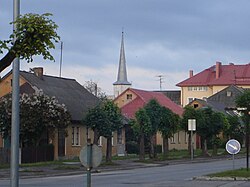Jõhvi
| Jõhvi | |||
|---|---|---|---|
| Town | |||
 |
|||
|
|||
| Location in Estonia | |||
| Coordinates: 59°21′27″N 27°25′37″E / 59.35750°N 27.42694°ECoordinates: 59°21′27″N 27°25′37″E / 59.35750°N 27.42694°E | |||
| Country |
|
||
| County |
|
||
| Municipality |
|
||
| Founded | 1938 | ||
| Area | |||
| • Total | 7.62 km2 (2.94 sq mi) | ||
| Population (2013) | |||
| • Total | 10,775 | ||
| • Density | 1,400/km2 (3,700/sq mi) | ||
| Ethnicity | |||
| • Estonians | 34.5% | ||
| • Russians | 55.7% | ||
| • other | 9.6% | ||
| Time zone | EET (UTC+2) | ||
| • Summer (DST) | EEST (UTC+3) | ||
| Postal code | 71501 to 71599 | ||
| Area code(s) | (+372) 22 | ||
| Website | www.johvi.ee | ||
Jõhvi (German: Jewe, Russian: Йыхви) is a town in north-eastern Estonia, and the capital of Ida-Viru County. The town is also an administrative centre of Jõhvi Parish. It is situated 50 km from the Russian border.
Ethnic Estonians are a minority in Jõhvi, as about 55% of the town's population are ethnic Russians.
Jõhvi was first mentioned as a village in 1241 in Liber Census Daniae when it was ruled by Denmark. Historical names of Jõhvi were Gewi and Jewi. In the 13th century a church was built here and Jõhvi became the centre of the local church parish.
On 1 May 1938 Konstantin Päts renamed the Jõhvi borough a town along with nearly all Estonian boroughs. Up to 1991, Jõhvi was a district of Kohtla-Järve. In 2005 the town of Jõhvi was united with the parish of Jõhvi.
Jõhvi is twinned with:
Jõhvi church
Central square
Jõhvi Gymnasium
Jõhvi promenade
Statue of Estonian military commander Aleksander Tõnisson
Jõhvi Concert Hall
Jõhvi Central Library
Jõhvi at night
Monument in memoriam of Kaljo Kiisk
...
Wikipedia



